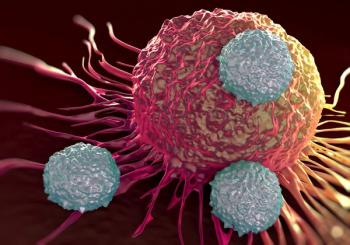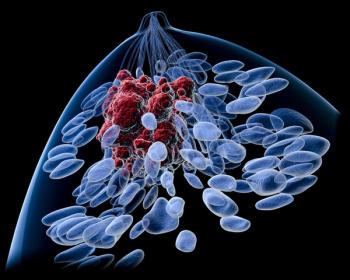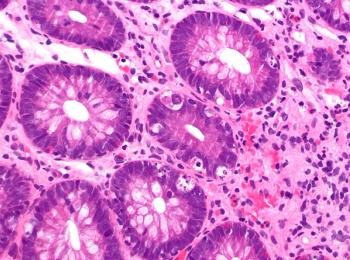
Oncology NEWS International
- Oncology NEWS International Vol 11 No 4
- Volume 11
- Issue 4
DHA Conjugate Increases Paclitaxel Uptake by Tumor Cells
NEW YORK-A novel taxane/fatty acid conjugate designed to increase taxane activity in tumor cells and decrease toxicity has shown promising results in a phase I trial of patients with solid tumors. Ross Donehower, MD, professor of oncology and medicine, Sidney Kimmel Comprehensive Cancer Center at Johns Hopkins University, presented the findings at the Chemotherapy Foundation Symposium XIX (abstract 73).
NEW YORKA novel taxane/fatty acid conjugate designed to increase taxane activity in tumor cells and decrease toxicity has shown promising results in a phase I trial of patients with solid tumors. Ross Donehower, MD, professor of oncology and medicine, Sidney Kimmel Comprehensive Cancer Center at Johns Hopkins University, presented the findings at the Chemotherapy Foundation Symposium XIX (abstract 73).
DHA-paclitaxel (Taxoprexin, Protarga, Inc) is a combination of paclitaxel conjugated at the active site to docosahexaenoic acid (DHA), an essential fatty acid, "which serves, in this concept, as a target vector for tumor cells," Dr. Donehower said.
Tumor cells actively take up and utilize fatty acids, both as membrane precursors and as energy sources, to a greater extent than do noncancer cells. "It’s felt that perhaps this would be a way in which taxanes could be introduced more effectively into the cell," he said.
After preclinical studies provided evidence that DHA-paclitaxel did increase paclitaxel uptake by tumor cells, a phase I trial was initiated at Johns Hopkins. The study enrolled 24 patients with a variety of solid tumors. All 13 men and 11 women had received prior chemotherapy. "We did eliminate patients who had anything more than mild peripheral neuropathy," Dr. Donehower said, "because of the desire to ascertain whether or not DHA-paclitaxel does cause peripheral neuropathy."
The drug was given in a 2-hour infusion every 21 days. Doses escalated from 200 mg/m² to 1,100 mg/m². At an evaluation after the first two cycles of treatment, Dr. Donehower reported, "roughly half the patients were stable or in one case responding." After four cycles of therapy, 6 patients continued to have stable disease. Overall, 10 of 21 evaluable patients achieved stabilization, and 1 had a complete response.
The major and dose-limiting toxicity was neutropenia, Dr. Donehower reported. Of the nine patients who received 1,100 mg/m² DHA-paclitaxel, seven had grade 3-4 febrile neutropenia, he noted. At the next lower dose of 880 mg/m², grade 4 neutropenia was seen in three of the six patients, but only one of these patients became febrile. Nonhematologic toxicity was generally mild.
Pharmacokinetic analyses showed that the volume of distribution of DHA-paclitaxel was "about 1/50th that of paclitaxel," Dr. Donehower reported, "and it circulates in this nontoxic state." The clearance rate, he added, is slow, approximately 1/300th that of paclitaxel. The half-life of the paclitaxel derived from DHA-paclitaxel was about 80 hours, compared with 8 to 10 hours for Taxol.
"There is no accumulation of the drug despite the long half-life," he noted, since concentrations were similar over four courses of therapy at 1,100 mg/m².
The DHA-paclitaxel dose recommended by Dr. Donehower and associates for phase II studies is 1,100 mg/m². Phase II studies of DHA-paclitaxel, he said, are currently enrolling patients with melanoma and cancers of the colon and rectum, pancreas, kidney, breast, lung, and prostate.
Articles in this issue
over 23 years ago
Virtual Shared Specimen Resource ‘Essential’over 23 years ago
Letrozole Superior to Tamoxifen in Metastatic Breast Cancerover 23 years ago
S-8184 Paclitaxel Emulsion Promising in Phase I Studyover 23 years ago
HIV+ Veterans Have Higher Rates of Unusual Cancersover 23 years ago
Online Breast Cancer Support Groups Beneficialover 23 years ago
Survival Benefit With Capecitabine/Docetaxelover 23 years ago
FDA Approves Zometa for Cancer-Related Bone Complicationsover 23 years ago
New Blood Test for Early Ovarian Cancer in Clinical TrialsNewsletter
Stay up to date on recent advances in the multidisciplinary approach to cancer.

















































































